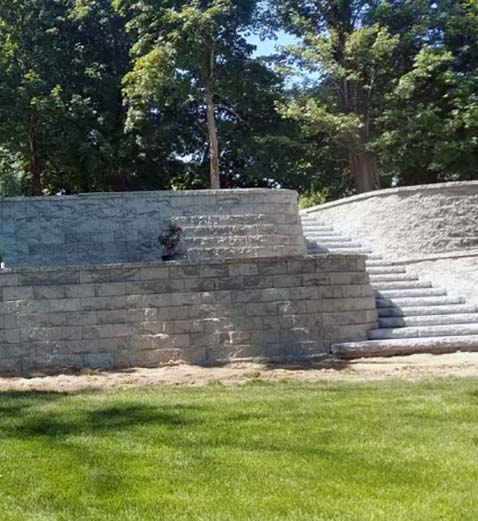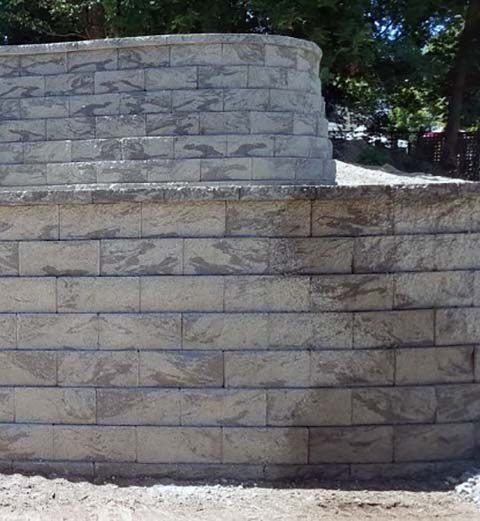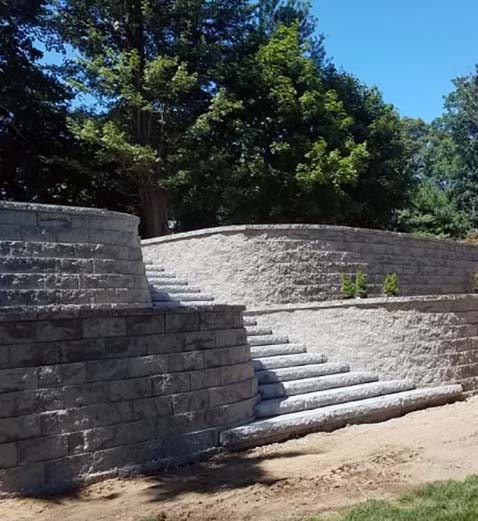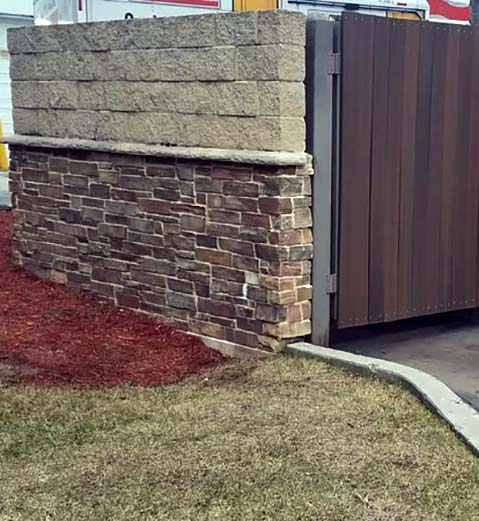LANDSCAPE BLOCKS
About Landscape Blocks
Wall blocks are preformed pieces of concrete that can be used to create a variety of beautiful and sturdy structures, including garden walls, retaining walls, and more. These walls are great for adding structure to your yard and garden. They can even be multifunctional and provide a place to plant flowers or add seating. Menards® offers a variety of durable block products as well as useful resources to help plan your project, choose your materials, and construct your new wall.
Garden Walls
The blocks used for garden walls are lightweight, relatively small, and are designed to build walls up to 24″ in height. These structures work best as an accent wall around the yard and garden. Garden walls are also perfect for terracing or building a raised planter. They are quick to install and are perfect for a weekend project.
Retaining Walls
Retaining walls are attractive and functional structures that look as though they have been built effortlessly, but they are carefully engineered to contain soil and withstand the force of gravity. These structures are a practical solution for areas where there is hillside erosion and where foundations are losing supporting soil or under pressure from sliding soil.
Freestanding Walls
Freestanding walls are used to add definition to a yard or garden. These types of walls are ideal for many different applications, including patio barriers, fencing or seating walls.
Characteristics to Consider
Size: Depending on whether you are building a short retaining wall for the plants around a home or a tall one next to a road, the materials you choose may change. When the wall is smaller, it also does not need to be built extremely solidly. You might construct it out of wood, stones, or slighter stacked concrete blocks that rely on gravity rather than a mortar substance to hold them in place. A big retaining wall that is part of the local infrastructure may instead be made of thicker timber, boulders, or poured concrete, which can sustain heavier weight loads.
Water Exposure: The degree to which water exposure presents in the area is another important factor to keep in mind when choosing the right retaining wall material. Water can come in the form of waves, precipitation, and humidity in the air. Your retaining wall might protect a coastline, or it may be nowhere near a body of water but still need to deal with a sizeable amount of moisture around it. In the case of the former, you should seek to maximize its durability with a material such as concrete. This is also ideal because it can be shaped into a sloped design that deflects the force of the oncoming water easier than materials that are made of stacked units.
If you’re contending with humidity and frequent rain and/or snow, you may avoid wood since it can start to rot in a perpetually moist environment. Brick, stone, and concrete blocks will stand up to the water better so long as you incorporate proper drainage into the retaining wall.
Style: The client you are making a retaining wall for may hold its looks at high priority too. You can offer them more leeway the less extensive the project is, as big retaining walls will still need to prioritize safety at the end of the day, and they have more weight and force that they must weather. Where possible, wood or stone can give the wall a natural, pleasing look that fits in well with the landscape and the architecture of nearby buildings like homes. Know that you can also improve upon the style of a retaining wall with outer finishes in some cases as well. For example, concrete may be the most reliable solution in a specific instance, but you can cover it with a façade that mimics the appearance of stone.
Common Types of Materials
Wood: Wood is a material that gives off a classic and rustic feeling. The grain and texture are visually warm and familiar, making it desirable when aesthetics are important for a retaining wall. This is because it comes from a source that was once living, so it is easy for it to mesh well outdoors with plants and earth. Wood is also easy to handle and cut into whatever shape you need for a wall, owing to its degree of flexibility and its lighter weight.
The downside to wood is that it isn’t as resilient or sturdy as many other options. It cannot take on too much weight and can eventually decay from water and insects. You must treat it with chemicals and routinely perform maintenance to keep it in good condition as time passes.
Stone: Stone, like wood, has been used to erect structures for ages because of its robustness. It’s also close to nature in composition and appearance, which enhances its visual appeal. To form retaining walls, it may be cut into even blocks that fit together smoothly or it may fill a wire framework in gabion-style retaining walls. These ways of using stone can drastically change how you work with it.
Blocks bring out the beauty of stone and can be arranged to fit whatever land shape you’re working with easily since they don’t need anything to stick them together. The process of placing them down can be slow, though. Putting stones into a gabion frame is simpler, but it can look more rustic. The wires that make up the frame can also corrode because of water.
Brick: Brick is classified as a material in itself, but its composition can vary. Clay, lime, and sand may be mixed into bricks. Despite this, you can expect to see shared features among most bricks. You don’t need to worry about moisture with brick, and it’s reasonably durable. Unlike stone, you do need mortar in between bricks to hold them together, though. In addition, exchanging a damaged section of a brick retaining wall is a tricky task to accomplish, since the whole wall’s integrity may be compromised.
Concrete: Concrete comes in two forms: blocks and poured concrete. Concrete blocks are better for shorter walls, as going too high with them will result in a weak structure. They are relatively simple to put in place, and there is a wide selection of dimensions that you can choose from. Furthermore concrete is tough, so while you lose stability with a large block wall, you can be sure that each unit will stand up to weather and the force of the soil on it.
Poured concrete: Poured concrete is transferred in a liquid state into molds at the construction site where it hardens into the shape needed for the retaining wall. Since there are fewer pieces involved, it can support much greater amounts of earth than concrete blocks and is common in infrastructural retaining walls. You aren’t just limited to a straightforward vertical wall, either. Some poured concrete walls are reinforced with a horizontal concrete base located underground that stops them from moving (cantilever walls), and others have visible triangular columns that fortify them (counterfort walls). For all its benefits, concrete does have a cold, austere appearance, however.
Plastic lumber: Plastic lumber brings together a more natural appearance with durable properties. HDPE plastic is molded into boards that can be given the surface grain texture of normal wood and which can be produced in a range of colors. Different shades of brown and gray are available, so the material can go well with different organic surroundings.
At the same time, the plastic makes it completely resistant to wood’s usual weaknesses of water and decomposers. Plastic lumber may further have fiberglass mixed into its composition, upping its hardiness to the point where it can be used as structural lumber fit for big projects. Reinforced types can withstand the crashing of coastal waves and the weight of large chunks of earth.
RETAINING WALL PROJECTS








































SPECIALTY Masonry Services
Contact Lusitania Masonry
Masonry Office
448 Hagerman Avenue
East Patchogue, NY 11772
Masonry Inquiries
For any inquiries, questions or quotes, please call
631-520-8356 or fill out the form below.
Contact Lusitania
Tel: 631-520-8356.Tel: 877-520-5552.
Fax: 631-772-4768.
Email: ada@lusitaniamasonry.com.
Email: carlos@lusitaniamasonry.com.
Employment
To apply for a job with Lusitania Masonry, LLC., please send a cover letter together with your C.V. to: jobs@lusitaniamasonry.com.
Get A Masonry Quote
For a quote, inquiry or question about our services, please call 631-520-8356 or fill out the following form.


